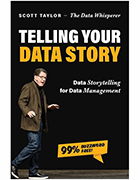Why your data story matters and how to tell it
Data storytelling isn't just for business analysts. Find out how to build a data management story and why you need to have one in the first place.
Analytics and data management are two sides of the same coin. You can't have one without the other, but sometimes it doesn't feel that way.
Data science and analytics jobs have consistently been labeled as some of the sexiest jobs on the market, while data management jobs are typically seen as less glamorous. That doesn't make data management any less important -- there's no analysis without high-quality data and strong governance practices.
While all this seems pretty obvious, at times gaining organizational investment for data management requires that necessity to be spelled out to senior management. That means pitching your data management strategy through a data story.
Scott Taylor discussed the importance of a data story and how to build your pitch in his new book Telling Your Data Story: Data Storytelling for Data Management, published by Technics Publications.
What is your data story?
Data storytelling is most often associated with analytics and typically involves visualizations and insights. When it comes to data management, your data story is formulated differently and is often closer to a sales pitch than a visualization.
"Some people who haven't been in sales bristle at the idea of sales," Taylor said. "But I've been in sales and marketing my whole life, and I know its place and its effectiveness."
Most pitches will have the same skeletal structure because the importance of strong data management is similar across enterprises. But how you interpret your data management strategy's value to stakeholders is specific to each organization.
"Every enterprise, every business is trying to deliver value to their relationships through their brands at scale -- figure out your own version of that where you can fill in the blanks," Taylor said.
Your data management story is about selling C-suite executives on the value of a strong data strategy to help secure funding for data management projects. In his book, Taylor breaks it down into two buckets: Analytics tells stories with data, while data management tells stories about data.
A data story for data management will explore why your organization needs funding and describes what your data can do for business.
"[You're explaining] why many of the things that organizations want to do will not get done successfully if there isn't data management in place," Taylor said.
Where to start
When you're building a data story, you start with the same place as any other story: building the narrative.
"There are a lot of pieces, but if you don't have that narrative, all the rest of it doesn't matter," Taylor said.
The narrative of your data story is what connects the C-suite to your pitch. Building the relationship and connection is what helps you sell the strategy. Getting to that narrative starts with finding the why.
"Create a form of narrative that gets [executives] engaged and focuses squarely on the why, on the intentions [and] on the reasons that they're doing it, rather than the technical implementation," Taylor said.
There's a tendency to focus on the how of something -- getting from point A to point B and the steps it takes to get there -- but the why is the reason you're going to point B in the first place.
How to tell your data story
Once you have your why and you start to build your narrative, it's time to focus on how to tell your data story.
"You want to collect the three Vs: vocabulary, voice and vision," Taylor said.
Your story's vocabulary should consist of more than just industry jargon, he said. When talking to business professionals, it's also important to include their language; otherwise, they may not understand what you're trying to say.
As for voice, it's important for your team to be on the same page. Taylor said creating a harmonized voice isn't about everyone saying something the same way; it's about making sure everything sounds good together.
"Harmonize that voice, and you can borrow the voice of your own business," he said.
Not only is it important to borrow your voice from the organization's business, it's also the place to find your vision. The vision is where data management and the enterprise's strategic intentions combine, Taylor said. Executives want to glean the best insights from their data, which is only possible with a strong data management strategy.
This kind of story focuses on selling the importance of the data side of data analytics. Analytics and gleaning insights are often seen as more important, but having well-managed data is how you get those insights.
"The plot comes from analytics, but the characters come from data management," Taylor said.
In his book, Taylor compared relationship between data management and analytics to baking. A baker doesn't say flour has no importance until it becomes bread.
"They don't do that because they respect the ingredients," he said.
A data story helps others see the flour, chocolate, sugar and eggs instead of just the cake.
To learn more about telling your data story, check out this excerpt from Taylor's new book Telling Your Data Story, published by Technics Publications.
 Click here to learn more
Click here to learn more






